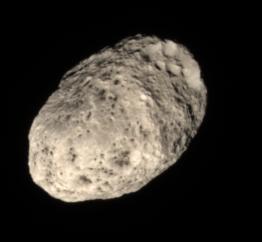پەڕگە:Hyperion in natural colours.jpg
Hyperion_in_natural_colours.jpg (٢٦٢ × ٢٤٢ پیکسڵ، قەبارەی پەڕگە: ٧ کیلۆبایت، جۆری ئێم ئای ئێم ئی: image/jpeg)
مێژووی پەڕگە
کرتە بکە لەسەر یەکێک لە ڕێکەوت/کاتەکان بۆ بینینی پەڕگەکە بەو شێوەی لەو کاتەدا بووە.
| ڕێکەوت/کات | ھێما | ئەندازە | بەکارھێنەر | تێبینی | |
|---|---|---|---|---|---|
| هەنووکە | ١٧:٢٤، ١٠ی تشرینی یەکەمی ٢٠٠٦ |  | ٢٦٢ لە ٢٤٢ (٧ کیلۆبایت) | Uwe W. | Original Caption Released with Image: Unlike most of the dull grey moons in the Solar System, Hyperion's color is a rosy tan, as this view shows. The origin of the moon's unusual hue is not known. Some scientists suspect the color comes from falling d |
بەکارھێنانی پەڕگە
ئەم پەڕەی 2ە ئەم پەڕگەیە بەکار دەھێنێت:
بەکارھێنانی سەرانسەریی پەڕگە
ئەم ویکیانەی دیکەی خوارەوەش ئەم پەڕگە بەکاردێنن:
- بەکارھێنان لە af.wikipedia.org
- بەکارھێنان لە als.wikipedia.org
- بەکارھێنان لە ar.wikipedia.org
- بەکارھێنان لە ast.wikipedia.org
- بەکارھێنان لە as.wikipedia.org
- بەکارھێنان لە az.wikipedia.org
- بەکارھێنان لە be.wikipedia.org
- بەکارھێنان لە bh.wikipedia.org
- بەکارھێنان لە bs.wikipedia.org
- بەکارھێنان لە ca.wikipedia.org
- بەکارھێنان لە de.wikipedia.org
- بەکارھێنان لە el.wikipedia.org
- بەکارھێنان لە en.wikipedia.org
- بەکارھێنان لە en.wikiversity.org
- بەکارھێنان لە es.wikipedia.org
- بەکارھێنان لە eu.wikipedia.org
- بەکارھێنان لە fr.wikipedia.org
- بەکارھێنان لە fr.wikibooks.org
- بەکارھێنان لە hi.wikipedia.org
- بەکارھێنان لە hi.wikiversity.org
- بەکارھێنان لە hr.wikipedia.org
- بەکارھێنان لە ja.wikipedia.org
- بەکارھێنان لە ka.wikipedia.org
- بەکارھێنان لە km.wikipedia.org
- بەکارھێنان لە ko.wikipedia.org
- بەکارھێنان لە kv.wikipedia.org
- بەکارھێنان لە lb.wikipedia.org
- بەکارھێنان لە lij.wikipedia.org
- بەکارھێنان لە lv.wikipedia.org
- بەکارھێنان لە ms.wikipedia.org
بینینی بەکارھێنانی گشتی زیاتری ئەم پەڕگەیە.



